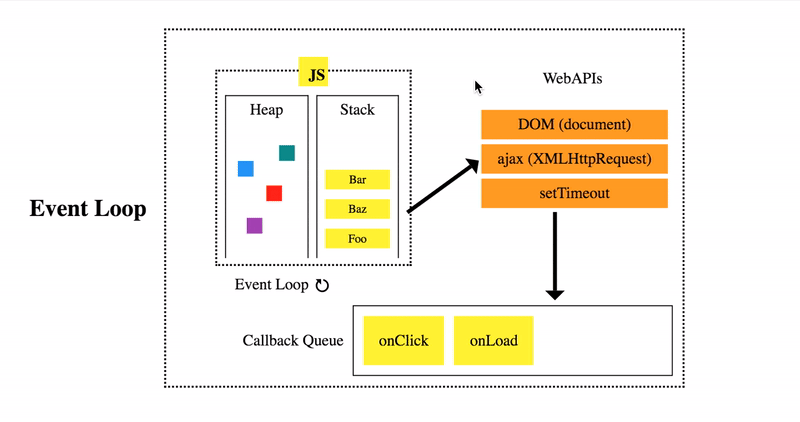1. Concurrency/Parallelism
To handle multiple tasks at the same time in OS we have:
-
Concurrency: running/managing the multiple computations —> the same time (interleaving operation).
-
Parallelism: running multiple computations —> simultaneously.

Source: baeldung.com
Most modern programming language support concurrency —> Improve performance/responsiveness (long-running I/O, blocking tasks, …).
While parallelism, multiple tasks are executed simultaneously on different processors/cores —> More challenging.
2. Event-based concurrency
Let’s go with concurrency for now, there’re generally two approaches with concurrency:
-
Thread-based: using multiple threads of execution to perform different tasks concurrently.
-
Event-based: using a single thread of execution that processes events as they occur.
There’re many languages support event-based concurrency such as: JavaScript, Python, Ruby,…
Event-based concurrency is mostly based on a construct known as Event Loop.
while (1) {
events = getEvents();
for (e in events) processEvent(e);
}The main loop simply waits for something to do —> for each event re-turned, processes them (Event handler).
3. Event Loop
Now, let’s dig a bit deeper to Event Loop.
We call it ‘loop’ because it tends to infinitely loop checks for events in the event queue —> If there’s any, then process them —> Event handler will execute them.
The event queue can be implemented using a variety of data structures: linked list, a priority queue, or a circular buffer…

Source: Medium / Event loop in JS
Event Loop runs on single threads:
-
Pros: Shared resources, resolve most problems with concurrency:
- No needs to implement locks.
- Can not interrupted by others threads.
-
Cons: Blocking system calls (events such as: HTTP request, I/O tasks,… may take long-running time —> block Event Loop —> Unable to process other events).
To solve the above problems, here’s come the Asynchronous I/O.
4. Asynchronous I/O
Asynchronous I/O is implemented in most modern OS —> helps programs to perform I/O operations without blocking the main thread of execution.
As we known, I/O operations include:
- Sync (Blocking I/O): do all the works —> return the caller.
- Async (Non-blocking I/O): do some works —> return immediately (get work done in background).
Asynchronous I/O is also known as Non-blocking I/O.
How it works:
- I/O operation is initiated —> the program will register a callback function or event handler —> get execute when operations are completed in background.
This is widely used in many programming languages. JavaScript with callback, Python/C# with async/await syntax.
5. Asynchronous Programming
Asynchronous Programming is well-suited in applications programming compared with Synchronous Programming.
Asynchronous Programming relies on Asynchronous I/O to perform I/O operations in a non-blocking way.
As described above, callback is the key of Asynchronous Programming.
6. Promise in JavaScript
We all known that use callback somehow will lead to callback hell.
Then, promise was introduced in ECMAScript 2015 (ES6) —> more organized and structured way than callback.
- Create promise:
const promise = new Promise((resolve, reject) => {
// Do some asynchronous operation, such as making an HTTP request
fetch("https://example.com/api/data")
.then((response) => response.json())
.then((data) => {
// If the operation completes successfully, call resolve with the result
resolve(data);
})
.catch((error) => {
// If the operation fails, call reject with an error object
reject(error);
});
});Actually, the fetch() function above returns a promise itself 😅.
- Consume promise:
promise
.then((result) => {
// Handle the successful outcome of the Promise
console.log(result);
})
.catch((error) => {
// Handle any errors that occur during the Promise
console.error(error);
});But with chain promise, we need to use .then() a lot —> hard to read, maintain. And promise is not cancellable as well.
7. Here’s come Async/Await
Remember that it just a syntactical sugar to consume Promise, so instead of using .then() and .catch() —> async/await. It’s built on top of Promise.
—> Write asynchronous code in a more synchronous, readable way.
Async/Await was introduced in ECMAScript 2017 (ES8). Meanwhile, this syntax was introduced sooner by other languages: Python, C#.
async function getData() {
try {
const response = await fetch("https://example.com/api/data");
const data = await response.json();
return data;
} catch (error) {
console.error(error);
throw new Error("Failed to fetch data");
}
}In order to handle errors we need to wrap them inside a try/catch block.
Refs:
Asynchronous Programming in JavaScript – Guide for Beginners
Book: Operating Systems: Three Easy Pieces - Remzi H. Arpaci-Dusseau